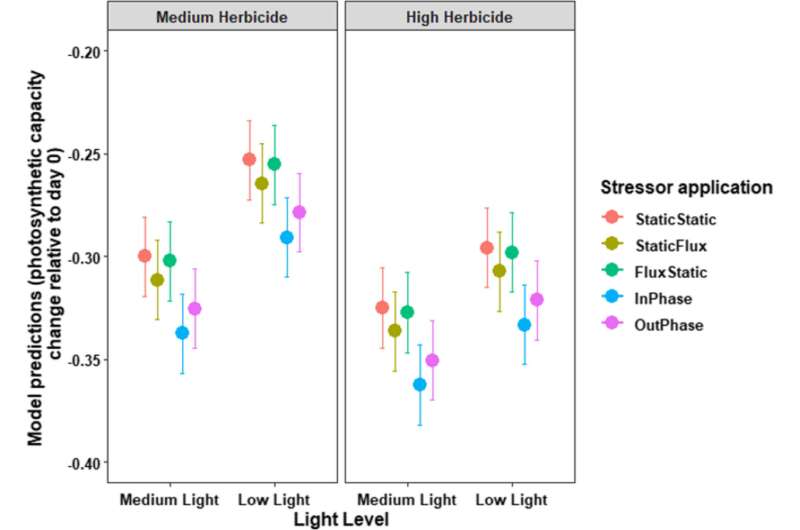Biomass change. Model predictions for mean (±SE) proportional biomass change for four stressor treatment combinations tested across the five variations in stressor intensity and synchronicity. The dashed line indicates no change from initial biomass prior to stressor exposure. Asterisk indicates a significant effect of variable stressor intensity and synchronicity relative to static-static (p < 0.05). Each treatment combination was replicated 12 times. Credit: Ecology Letters (2022). DOI: 10.1111/ele.14120
Griffith University research reveals that when combinations of human-caused stressors fluctuate, replicating more realistic environmental conditions, it vastly changes their impact on wetland habitats.
Published in Ecology Letters, the study shows that when the level of stressors, like chemical pollution and reduced light conditions from sediment disturbance or algal blooms, change over time, as they would in real-world exposures, they caused more seagrass loss than when a stressor of the same intensity was constant over time.
"With ecosystems around the globe increasingly affected by human activities it's not surprising that environments are rarely exposed to a single stressor," said lead author Ms. Andria Ostrowski, a Ph.D. candidate at the Australian Rivers Institute and the Coastal & Marine Research Center.
While it is recognized that interactions between co-occurring stressors can cause unexpected synergistic or antagonistic impacts on the environment, the effect that changing levels of stressors can have is less understood.
"In dynamic aquatic ecosystems stressors rarely remain static in the environment, yet we continue to conduct multi-stressor experiments that assume stressor levels remain constant," Ms Ostrowski said.
"For example, changes in tide or water flow rates mean that any potential contaminant or stressor is unlikely to remain at a constant intensity for very long in aquatic ecosystems.
"Our study, which explored what happens when stressors fluctuate, found that the way in which the chemical pollution and light reduction stressors are varied over time elicits different biological responses in seagrasses."
Seagrass, in addition to providing critical habitat for wildlife like fish, sea turtles and dugongs, stabilizes sediments, stores carbon, protects coastlines, and improves coastal water quality.
"This critical habitat is disappearing globally due to simultaneous human-introduced stressors like pollutants, physical disturbance, and increasing temperatures," Ms. Ostrowski said.
"By understanding how these multiple stressors interact and fluctuate under the dynamic environmental conditions that occur in coastal ecosystems and the impact this has on seagrass habitats, we can better manage adverse effects.
When the researchers looked at seagrass responses to changes in stressor intensity for reduced light conditions paired with herbicide contamination, they found that when these stressors were out of phase (peaking at different times, referred to as asynchronous fluctuations), the amount of seagrass was reduced by more than a third (36% less seagrass biomass) compared to static stressor conditions, despite exposure to the same overall average level of stressors.
"Our results provide evidence that the biological response of ecosystems like seagrass habitats does change depending on how and when the stressors are introduced to the environment," Ms. Ostrowski said.
"For this reason, past studies in which the levels of multiple stressors have been kept constant, may not provide a comprehensive understanding of real-world effects.
Senior author Dr. Michael Sievers said, "The future assessment of multiple stressors needs to incorporate environmentally relevant changes in stressor levels and timing if we want to gain a more accurate understanding of real-world impacts and thus lead to the development of better conservation and management strategies, for seagrasses and other ecosystems."
More information: Andria Ostrowski et al, Fluctuating fortunes: Stressor synchronicity and fluctuating intensity influence biological impacts, Ecology Letters (2022). DOI: 10.1111/ele.14120
Journal information: Ecology Letters
Provided by Griffith University
























